During the 20th century the population growth continued:
|
Year |
Population |
|
1901 |
15,395 |
|
1911 |
17,100 |
|
1921 |
18,200 |
|
1931 |
19,700 |
|
1939 |
20,200 |
|
1951 |
22,000 |
|
1961 |
22,300 |
|
| The town's first market was established in 1896. It occupied both sides of Church Street between
Bilston Street and New Street. After 35 years it moved
to New Street, and later to King Street, but eventually
died out from lack of support. A new market began in
1977 in King Street, but slowly seems to be suffering
the fate of its predecessor. In the late 1890s electricity came to the town, and was
supplied by two companies; The Midland Electric Corporation for
Power Distribution Limited in Church Street, and The Blast
Furnace Power Syndicate, which quickly disappeared. |
|
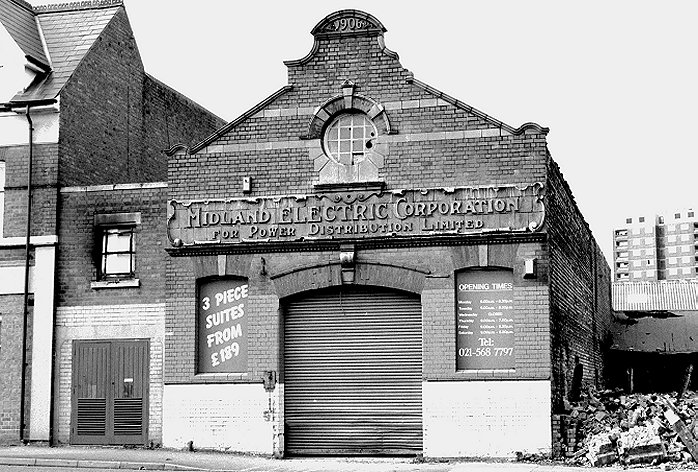
The old electricity
sub station in Church Street. |
| Darlaston Fire Brigade was formed after a fire
damaged the Cottage of Content pub in Bull Street on
12th April, 1895, which was Good Friday. Crescent Road Fire Station was built in 1896 at a
cost of £90.
The first fire brigade consisted of
volunteers and the engine was drawn by two horses named Nobby and Hellfire Jack. They were often borrowed by Mr.
Turner, who as well as being one of the volunteers was
also a coal merchant. In the late 1920s, Councillor
Simmonds presented the town with its first motor fire
engine, nicknamed Rose after his daughter.
For many years the Fire Brigade was run by
Darlaston's Town Surveyor, John Cash Joynson. The
members in 1916 were:
|
Hon. Captain
|
J. C.
Joynson |
|
Engineer |
Arthur
Gilbert |
|
Second
Engineer |
J. West |
|
Sergeant |
S. Bailey |
|
Driver |
G. Taylor |
|
Corporal |
A. Latham |
|
Firemen |
W.
Wilmore, S. Gilbert, J. W. Parbott, J.
Mason,
J. Chambers, and T. W. Simpson |
The fire engine, the escape and all the appliances
were kept at the fire station in Crescent Road. Drills
were held monthly. Each fireman's house was connected to
the fire station by a telephone bell. Alarms were given
at the fire station, or police station next door.
Telephone number 23.
In the early 1920s the members of the brigade were as
follows:
|
Hon. Captain |
J. C.
Joynson |
|
Hon.
Lieutenant |
Councillor W. T. Willmore |
|
Engineer
|
Arthur
Gilbert |
|
Second
Engineer |
J. West |
|
Sergeant
|
A. Bayley |
|
Corporal
|
A. Latham |
|
Firemen
|
S.
Gilbert, J. Mason, J. W. Parbott,
T. W. Simpson, J. Chambers, B. Orton |
The Engineer, Arthur Gilbert, was a
member of the Darlaston Volunteers and a member of a
local troupe of hand bell ringers. He gave lessons in
hand bell ringing and became involved with the Havelock
Band, which later became Darlaston Town Band. His other
hobby was carving figures from blocks of salt. He left
the Fire Brigade in 1932 and was elected as a life
governor of the National Fire Brigades Association.
Other members of his family also joined Darlaston Fire
Brigade. They were his second son and his grandson. His
eldest son George was the brigade’s first mascot when he
was seven years old.
The Fire
Brigade was managed by the council's Fire Brigade
Committee. In 1921 the members were Councillors:
T.
Lowe, Chairman; J. Garrington; A. H. Partridge; G.
Smith; and W. T. Willmore. |
|
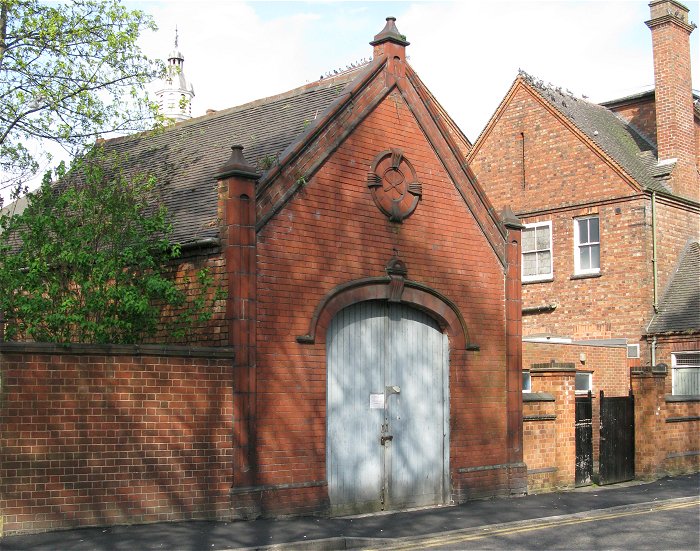
The old fire station. |

Darlaston fire brigade in about 1900.
|
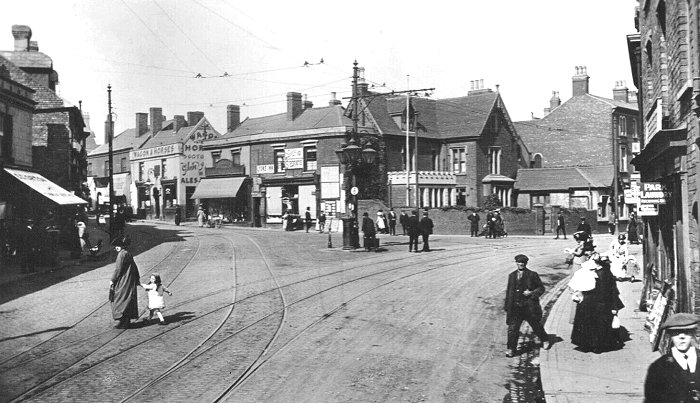
The Bull Stake in about 1900.
From an old postcard. |
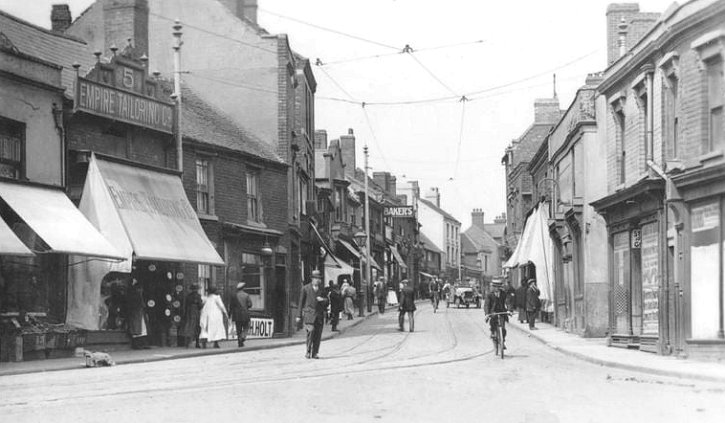
King Street in the 1920s.
|
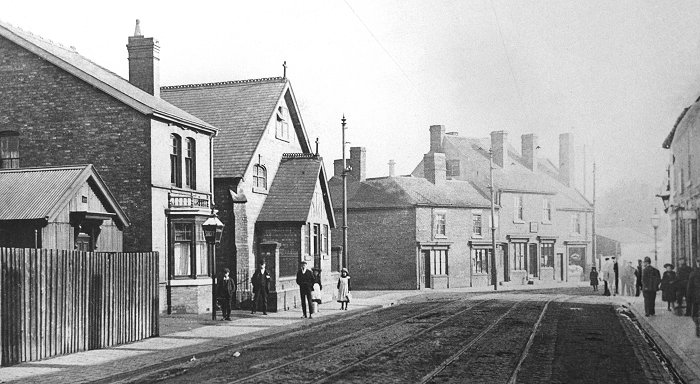
A fine view of old Blockall. |
| Darlaston's first police station was on the
south side of New Street,
next door to the Sir Robert Peel public house, on the
northern side of the Owen Memorial Garden. In 1861
it was run by Sergeant George McCrea, a 30 year old
Scotsman who live there with his wife Hannah and their
two children, Mary and Harry. Also living there were two
constables; Augustus Hooper and William Davies. In the
late 1860s the police station moved to a house at 25
Church Street, with 6 constables, and a sergeant.
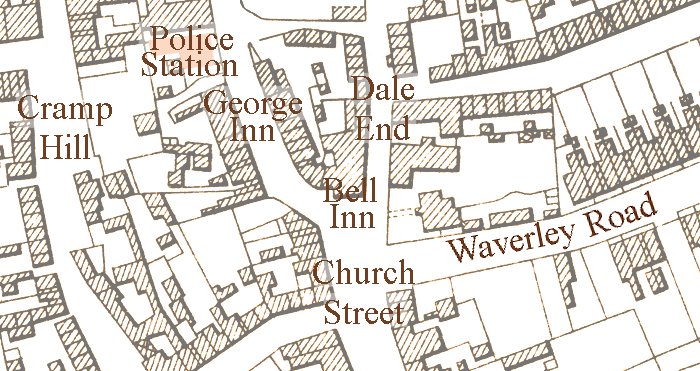
In 1899 Darlaston Police Station was built in
Crescent Road on land purchased from the council for the
princely sum of £7, due to the three mine shafts on the
site that had to be filled. The new Police Station was
administered from Stafford.
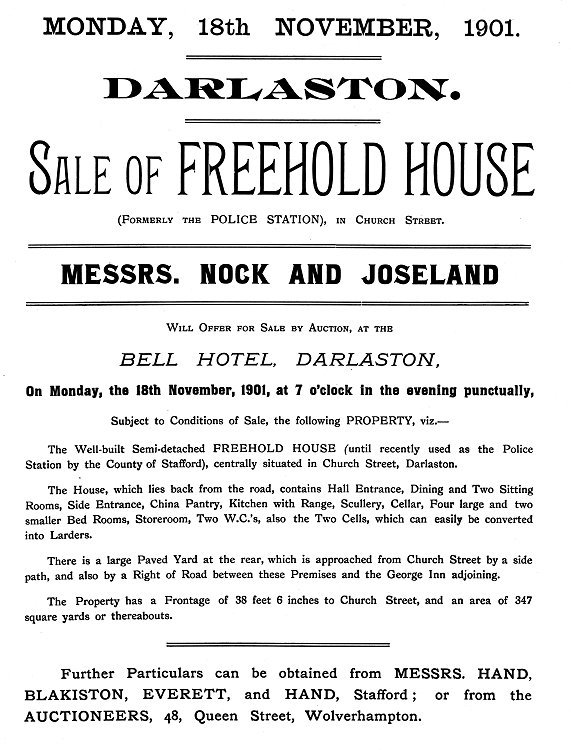
In 1909 the staff consisted of Inspector Williams,
Sergeant Findlay, and six constables, together with
another two constables who were stationed at Moxley.
They formed a Sub-Division of the Wednesbury Division. A Petty
Sessions was held at Darlaston Town Hall on alternate
Wednesdays. Special Sessions and Licensing Sessions were
also held.
In 1916 the staff at Crescent Road consisted of
Inspector Cooper, Sergeants Felthouse and Hull, and
seven constables. By the early 1920s the number of
constables had increased to twelve. |
|
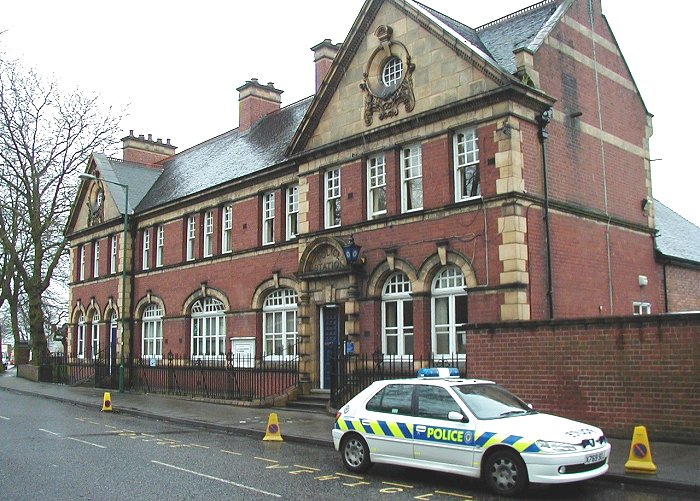
Darlaston Police Station. |
| Sadly at the beginning of 2018 it was decided to
close Darlaston Police Station and put the building
up for sale. The building sold for £660,000 at
auction on the 10th September, 2019 and is being
converted into apartments. It was Grade II listed in
April 2022, which will preserve the front of the
building. It is planned to build an extension at the
rear. It is very unlikely that Darlaston will ever
have another police station of its own. |
|
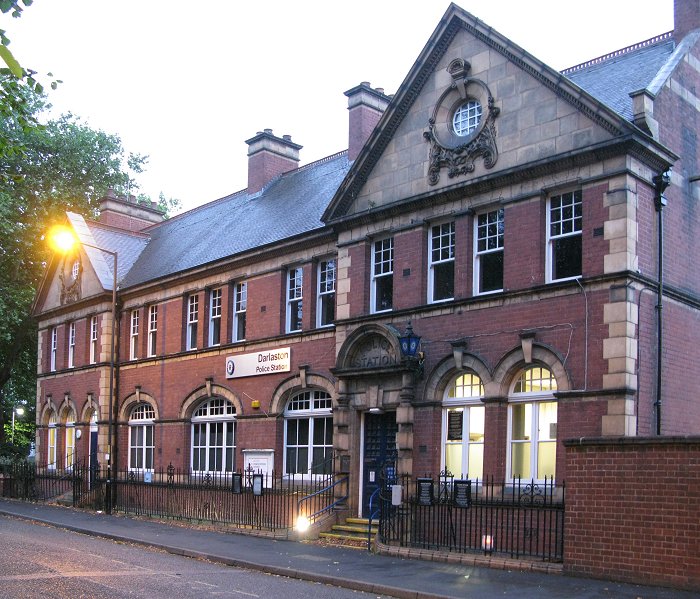
The Police Station, just
before closure. |
|

The rear of the Police
Station, which will be extended. |
|
The isolation hospital in Dangerfield Lane also
opened in 1899 following outbreaks of smallpox in the
area.
A post office opened near the top of King
Street with Miss Elizabeth Wright as Sub-Postmistress.
By 1909 the Sub-Postmistress was B. L. Canningsy.
Letters arrived daily from Wednesbury at 8.00a.m.,
2.00p.m. and 5.30p.m. They were dispatched at 9.15a.m.,
11.50a.m., 1.50p.m., 4.20p.m., 8.20p.m., and 9.15p.m.
Wall letter boxes were situated in Bell Street, The
Green, King Street, Pinfold Street, Catherine's
Cross, and the Bull Stake. They were emptied several
times each day and once on a Sunday. The postal
service seems to have been much better in those days
than it is today.
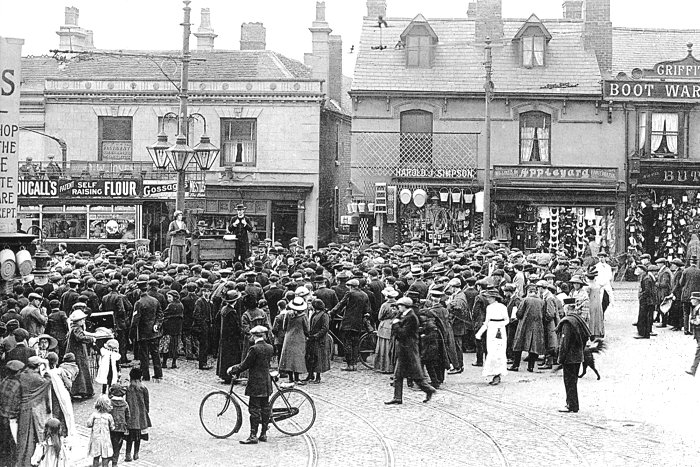
Some kind of religious meeting on
the Bull Stake in the early 20th century.
In 1912 the existing Sub-Post
Office in Victoria Road opened. Post was dispatched
at: 9.0 a.m., 10.15
a.m., 1.15 p.m., 3.15 p.m., 4.45 p.m., 6.0 p.m., 7.15
p.m., 8.15 p.m., and 9.15 p.m. On Sundays it was
dispatched at 8.15 p.m.
Deliveries were made at: 7.10 a.m., 11.10 a.m., and 6.10 p.m.
and on
Sundays at 7.20 a.m. Money Order and Savings Bank
business, Telegraph Office, Postal Orders, Telephone
Express Delivery and the Public Telephone Call Office
were all available from 8 a.m. to 8
p.m. on weekdays.
The Sub-Postmaster in 1916 was Mr. W. R. Woodhead, and
in the early 1920s the Sub-Postmaster was Mr. E.
John. |
|
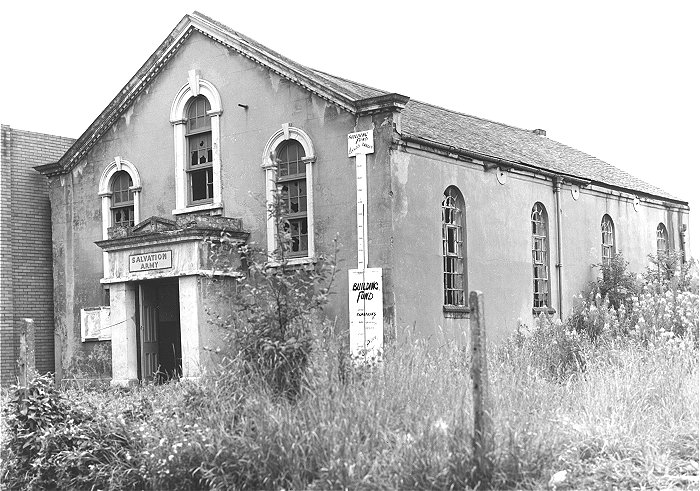
The Salvation Army's
church in High Street, just before it was demolished
to make way for the original Asda Supermarket in the
early 1970s. |
|
Darlaston Town Football Club was
founded in 1874. By the early 1890s the team regularly
played on the old Wakes Field off Waverley Road,
which became Darlaston Football Ground. The club
purchased the ground in July 1899, after which it became
known as City Ground. The team played in the Walsall and
District League before moving to the Birmingham Junior
League. 1911 was a landmark year for the club which won
the Birmingham Combination League Shield in the 1910/11
season. |
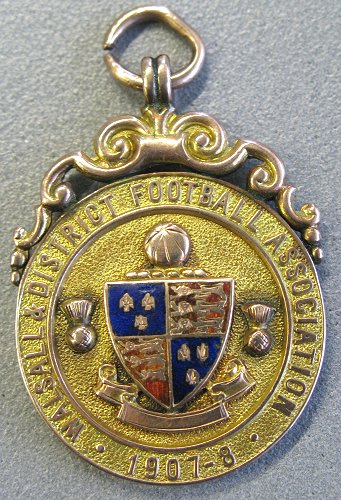 |
|
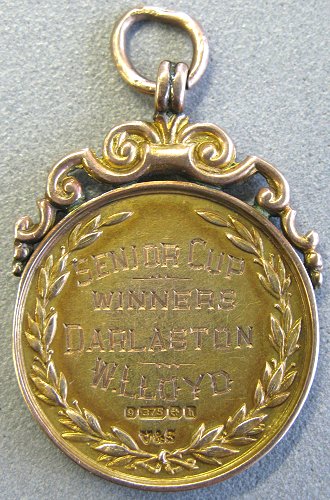 |
| A
medallion commemorating Darlaston's win in the
Walsall & District Football Association in the
1907/8 season. Courtesy of Graham William Lloyd.
It was presented to his grandfather W. Lloyd who
played in the winning team. |
|
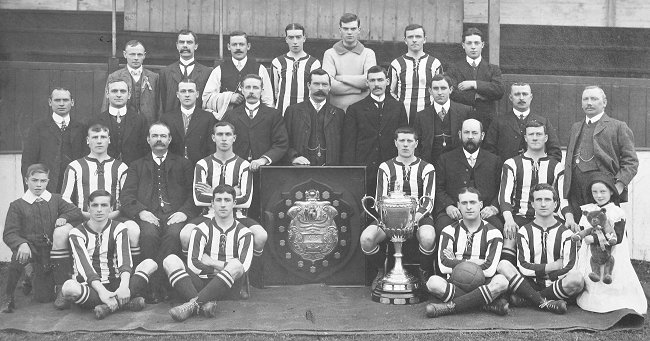
Darlaston's winning team in
1910/11. Courtesy of Graham William Lloyd.
Back Row left to right: J. Griffiths, F. Arnold,
R. Bourne (trainer), B. Lowe, H. Waite, I. Turner, and
H. Green.
Next row left to right: Wm. Hampton, R. Hampton,
W. Lee, Councillor H. Hemmings, C. H. Hollinshead
(vice-chairman), D. Walters, H. Guy (assistant trainer),
and T. Garbett (vice-chairman).
Next row left to right: E. Shinton, A. Martin, G.
Bould, J. Dennis, J. Constable, W. Lloyd, and H.
Blakemore (hon. sec.).
Front row left to right: ?, S. Reade, T. Watton,
G. Wilkes, E. Wilkes, and ? In the centre is the
Birmingham Combination League Shield, and the Walsall
Senior Cup. |
| At the turn of the century Darlaston's future looked
exceptionally bright. New factories were still opening,
employment was high, and King Street looked very
prosperous. Living conditions however for most people
were extremely poor, the old houses had not yet been
improved or replaced, and the population continued to
increase as more people came to look for work.
This
caused a serious overcrowding problem, with several
families often living in a single house. |
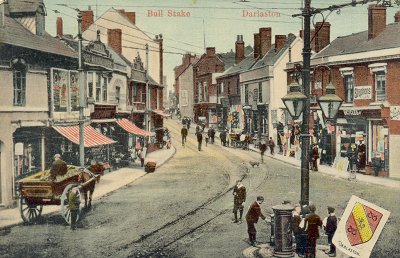
The Bull Stake and King
Street. From an old postcard. |

The James Bridge Aqueduct,
showing some of the farm buildings in front of
the old corn mill that belonged to the Lane
family. From an old postcard. |
|
The opening of Victoria Park
Martha and Jane Mills were the last two members of the
family who founded Bills & Mills, which became the
Darlaston Iron & Steel Company. They lived at Darlaston
House in Victoria Road, and had a country home at
Whitton near Ludlow. At the beginning of the century
they decided to leave Darlaston, and move to Whitton.
They gave the land on which the house was built to the
town for use as a public park. Darlaston House was
demolished, and Victoria park opened in 1902 as a
belated commemoration of Queen Victoria's Diamond
Jubilee.
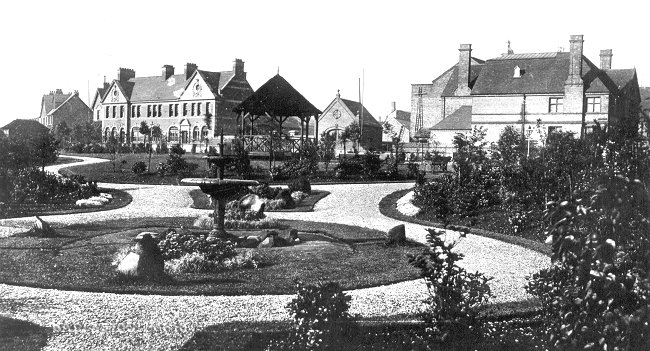
Victoria Park in the early 1900's.
From an old postcard.
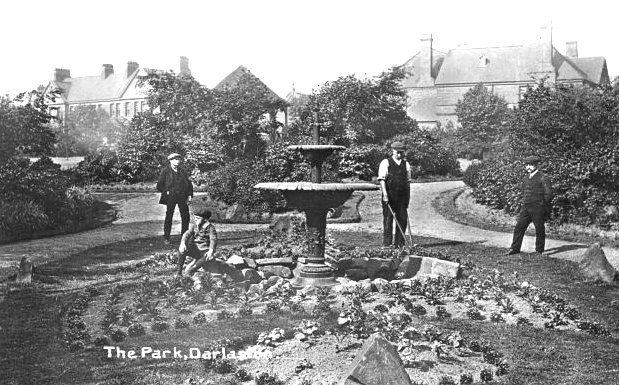
Another view of the park, from an old postcard.
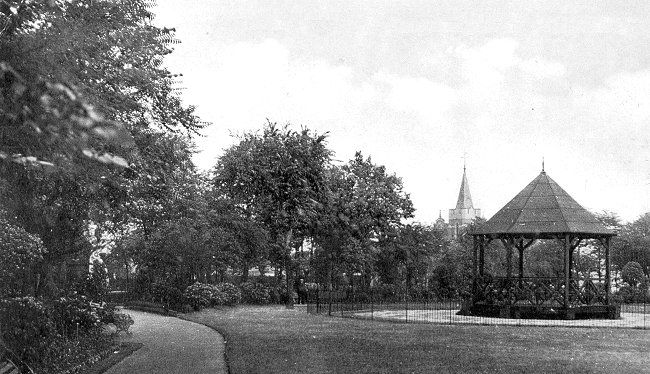
Another view of Victoria Park,
also from an old postcard.
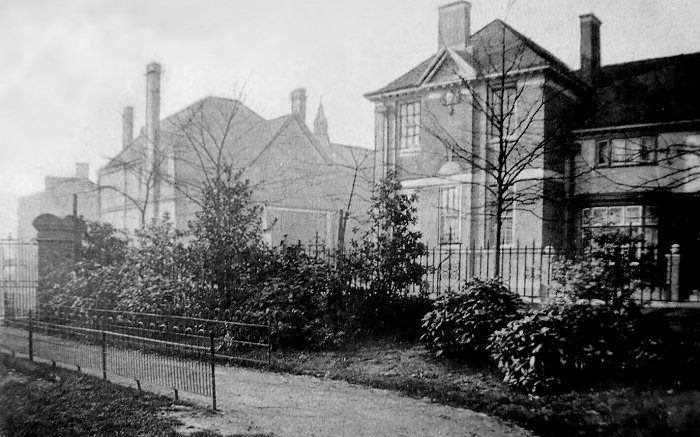
A view looking towards
the park entrance on the northern side of
Victoria Road, where the war memorial now
stands. Across the road is the new post
office that opened in 1912. From an old
postcard.
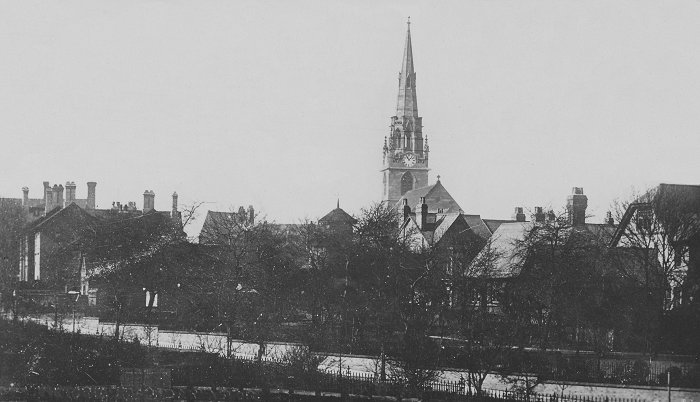
Looking towards Victoria Road from the park
before 1912 when the post office was built.
|
|
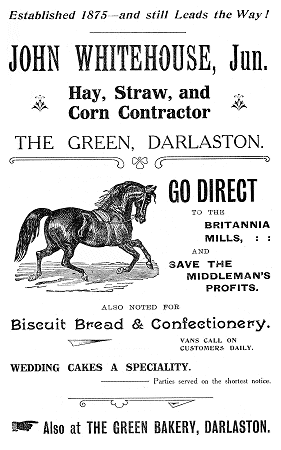
An advert from 1909. |
|
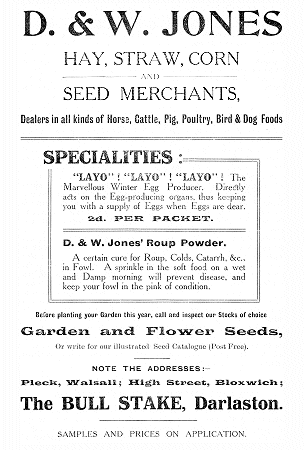
An advert from 1909. |
Bob Smith |
| Bob Smith founded one of the great institutions in
Darlaston and was known and liked by everyone.
In 1904
he had Favourite House built on the corner of Church
Street and Bilston Street, and it lived up to its name as
one of Darlaston's favourite shops. It was a shop,
showroom, workshop, warehouse, dwelling house,
hairdressing salon, photographic studio, and a garage
for his charabancs. Bob was born at Great Bridge on
13th June, 1869. He had a paper round and did
hairdressing while still at school. |
|
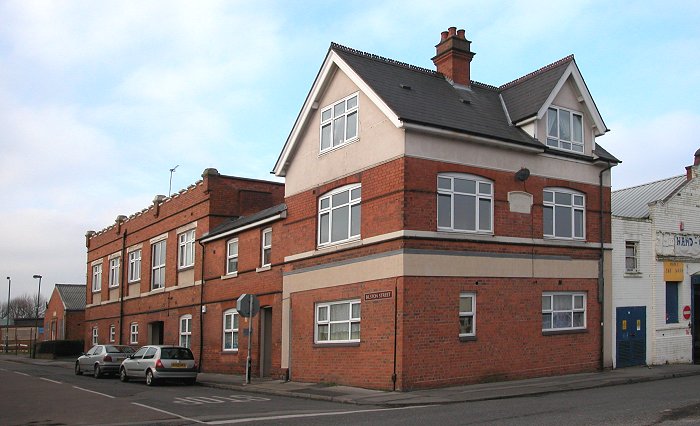
Favourite House in 2009. |
|
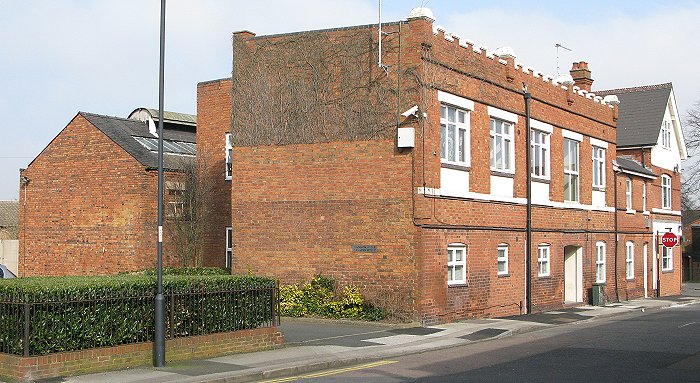
Another view of Favourite House. |
| He
taught himself glass cutting, watch and clock repairing,
and picture framing in his spare time, and also learned
gents hairdressing. When he left school he worked in a
bakehouse before getting a job at the Patent Shaft works
in Wednesbury.
At the age of 21 he married Sarah Jane,
and moved to a terraced house at James Bridge. He opened a barbers shop at
the house in the 1890s, and also did picture framing.
He decided to expand his business, and had Favourite
House built for the purpose. He had a roof
garden where he grew fruit including strawberries and apples,
and sold many things in the shop, including toys, fancy goods, jewellery,
hardware, and furniture.
Bob also carried out clock and
watch repairs, and ran a dolls hospital where he
repaired children's dolls.
There was an all-year round
club with over 2,000 members, who each paid a
subscription of one or two pence a week. This would soon
mount-up and could be spent on anything in the shop. It
was an early form of interest free credit. |
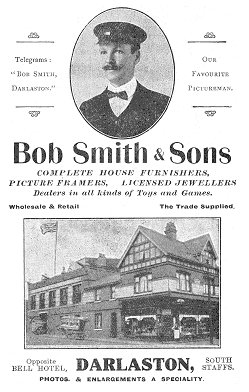
An advert from 1921. |
|
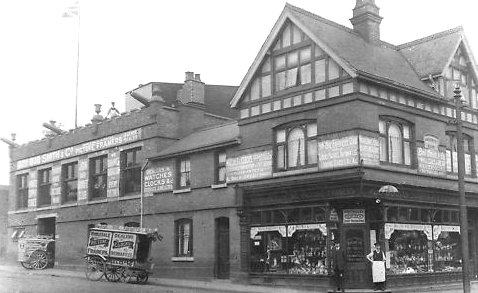
Bob standing in front of Favourite
House. From an old postcard. |
Bob's first vehicles were two horse-drawn delivery
vans, soon augmented by two motor coaches, used for his
'Favourite Motor
Trip Club' which ran trips to such places as Bridgnorth and
Bewdley.
Club members had cards on which they could pay
one or two pence a week towards the cost of their
outings. |
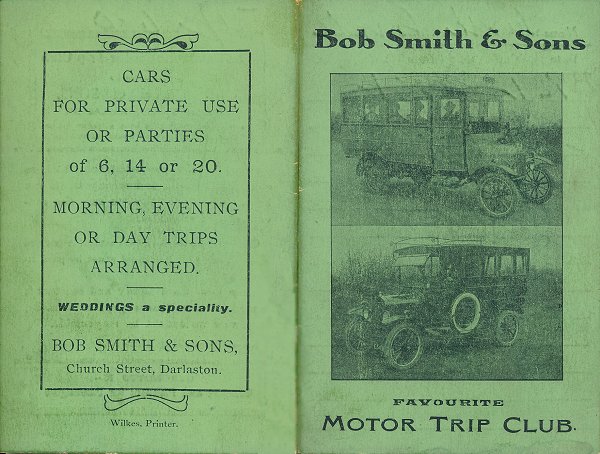
A payment card for the Favourite Motor
Trip Club.

The inside of the payment card.
| Bob also formed the 'Pictureman's Scout Troupe', and ran
the 'Meccano and Hornby Train Club'.
At Christmas he stood
outside the shop dressed as Father Christmas selling
penny dips.
In the general strike of 1926 with the help
of a group of ladies, and his scouts, he provided hundreds
of meals for the needy at his own expense.
Three of his sons and two of his daughters helped in
the business. Sadly his wife Sarah died on 15th
February, 1936 at the age of 65. |
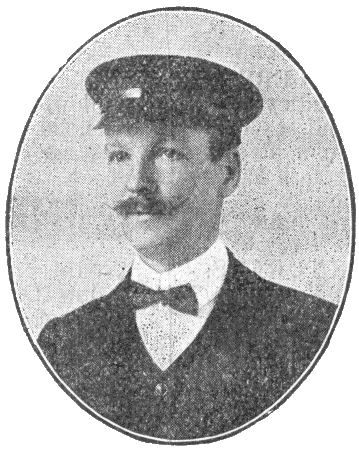 |
|
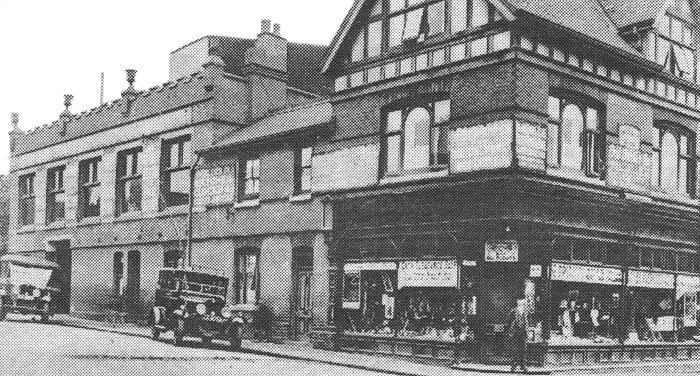
Another view of Bob Smith and
his shop, possibly from the 1930s. |
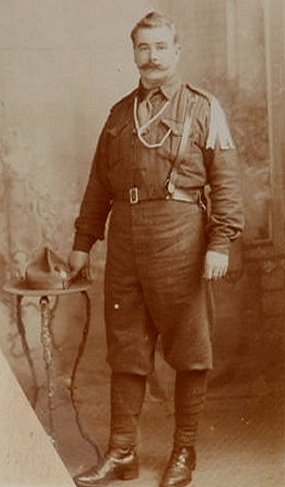
Bob Smith in his scoutmaster's uniform.
Courtesy of Dr. B. Williams |
During both
World Wars he gave generous help to people and organised
the Darlaston branch of the Express & Star War Comforts
Fund, placing collecting boxes in pubs and shops in the
area.
He was a councillor for many years representing
the Green Ward. Relaxation consisted of a game of cards
or billiards at the nearby Conservative Club.
In later years he was helped in the shop by his
daughter May, and housekeeper Eliza Fellows. When Eliza
died in 1955 he decided to retire. He was 85 at the
time.
He moved to his son George's house in Foley Street,
Wednesbury, where he died on 29th December, 1956 at the
age of 87. He is buried at James Bridge
Cemetery. |
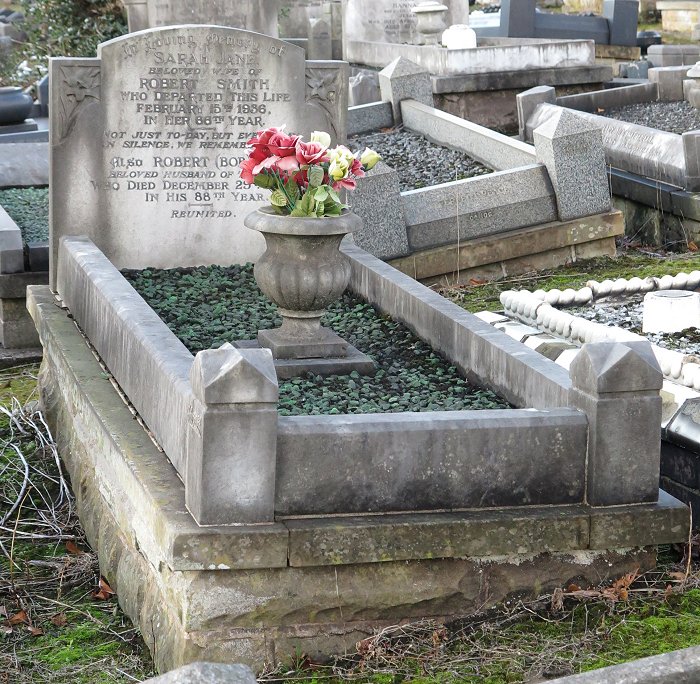
Bob Smith's grave at James Bridge
Cemetery.

A close-up view of the headstone on Bob
Smith's grave.
When Bob Smith retired, Favourite
House was taken over by Page's Electric Limited. The
business was there for many years and became well
known throughout the town.
|
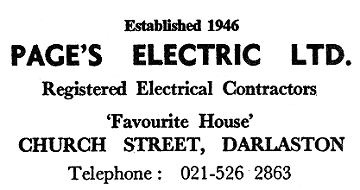
An advert from the
early 1970s. |
|
|
|
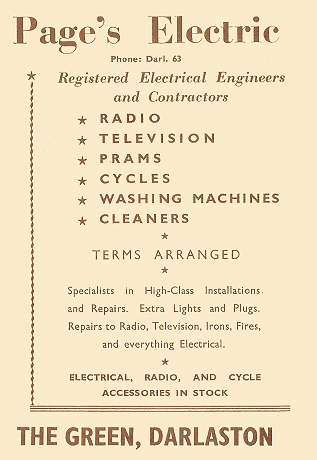
An advert from 1954.
Courtesy of Christine and John Ashmore. |
|

Avenue Road. From an old
postcard. |
|
William Stanbury
Anyone in their mid 50s or above will remember
Stanbury's gents outfitters shop near the top of King
Street.
The shop was well known and is still fondly
remembered today.
In the early 1900s William Walker Stanbury purchased
Poplar House, one of the last remaining town houses in
King Street, and added a single story extension on the
front. Around 1840 the late-Georgian Poplar House was
occupied for a time by Samuel and
Phoebe Mills, and their family. Samuel owned the
Darlaston Steel & Iron Company Limited at Darlaston
Green. |
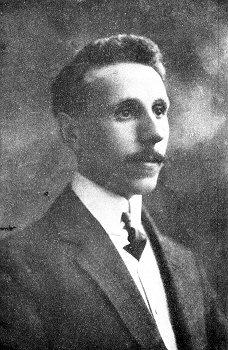
William Walker Stanbury. |
|

Poplar House. |
Some years later the
famous Victorian novelist Mrs Henry Wood stayed in the
house and whilst there wrote part of her best selling
novel "East Lynne", published in 1861. The house
later became a school for girls. Mr. Stanbury's business was very successful and he
became a local councillor. The shop remained in use
until the late 1960s, after which it became derelict.
After being empty for several years, the shop and house
were demolished in 1973. The modern ASDA supermarket
occupies the site today. William Stanbury became a prominent member of
Darlaston Urban District Council and served on a number
of council committees including the Finance Committee,
the Highways Committee, the Housing Committee, the Child
Welfare Committee, and the General Purpose Committee.
|
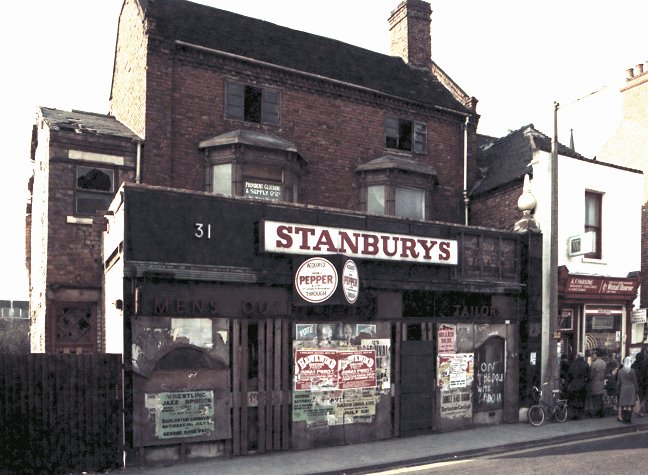
Stanbury's gents outfitters, 31
King Street.
|
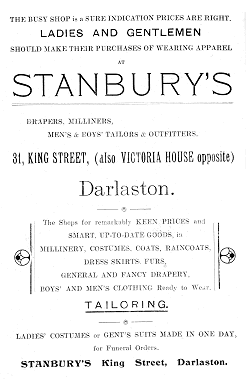
An advert from 1922.
|
He
was also Chairman of the Darlaston Tradesmen's
Association that helped to cultivate a friendly feeling
between fellow tradesmen and looked after their
interests.
The Association also exposed trading abuses,
helped in settling grievances, and attempted to remove
any restrictions on trading activities. |
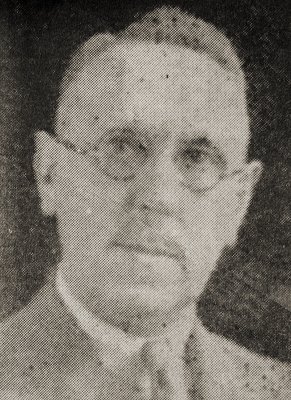
William Walker Stanbury in later
life. |
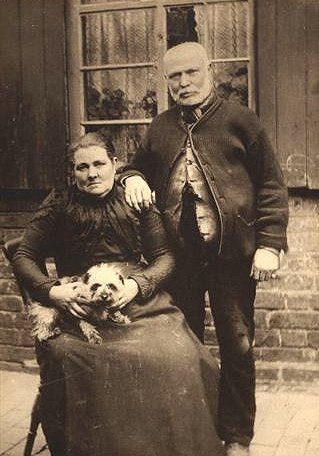 |
This lovely photograph was
kindly sent by Irene Bishop.
It shows John and Ann Maria
Stevens, and their dog Monty at the back of their home
in Cock Street where they had a shop.
They previously lived and
worked on canal boats around the Black Country. All of
their children were born at this time, and all survived. |
| One of the best known and longest surviving shops in
Darlaston was Jowett's, which sold fruit, vegetables,
flowers, and wet fish. The following description from
1914 is about the family's shop in Wednesbury, but it
equally applies to their shops in Darlaston:
Sidney Jowett, Florist, Fruiterer,
Fish and Poultry Dealer, Market Place, Wednesbury.
This popular
business was founded about eleven years back, and it
will be generally admitted that its proprietor is today
regarded as one of the most reliable and enterprising
representatives of the trade to be found anywhere,
possessing the most important and necessary
qualifications for successful trading in this branch of
business. The premises occupied by Mr. Jowett are known
as Market Stores, and have a capital corner position,
being also fitted up and arranged to meet all
requirements of each branch. Every description of fruit,
etc., in season; fish, poultry, and rabbits are to be
obtained here, also flowers, in which branch a
speciality is made of wreaths, crosses, bouquets, gent's
button holes and ladies sprays. In each line Mr. Jowett
is known to be most scrupulous in offering only the most
reliable and best quality goods at the lowest possible
prices, ensured by his exceptional purchasing facilities
in the best markets and large turnover. There is no
question in fact, that he offers every inducement to the
residents of Wednesbury to favour him with patronage,
and spares no effort to retain it when secured. |
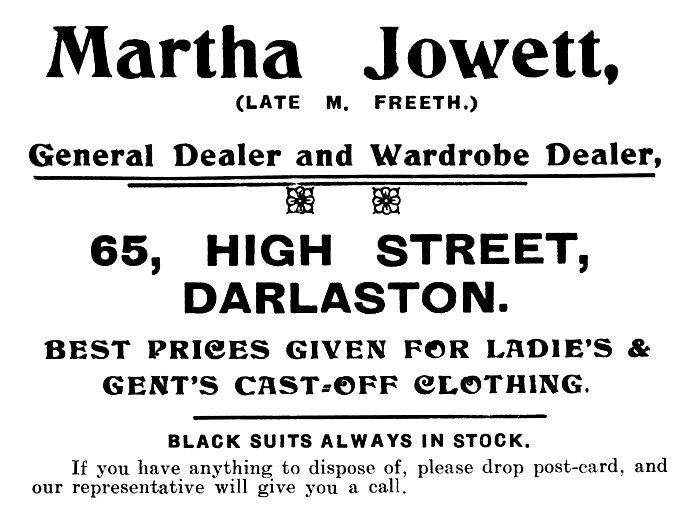
This advert from 1921, is for what is
believed to have been the Jowett family's first shop in
Darlaston.
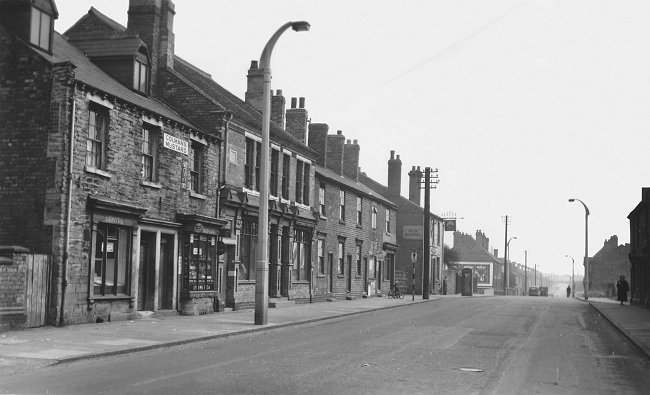
King's Hill. Courtesy of David Adams.
| In 1905 work began on the restoration of St.
Lawrence's church. The church tower was built very
roughly of bricks, and faced with cement that had been
scored to give the impression of stone. After a
thorough examination by an expert the building proved to
be unsafe and so a complete rebuild in stone was
undertaken.
The work, including a new clock amounted to
£3,000, much of which was raised by public subscription.
The new building opened in 1907.
|
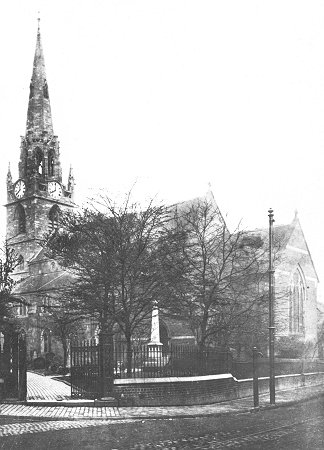
St. Lawrence's
Church. From an old postcard. |
 |
Another photo of St.
Lawrence's Church, also from a postcard.
The old entrance gates into the
churchyard are clearly visible. They were replaced by
the lich gate in 1943. |
| The town's Labour Exchange used to be at 34
King Street and was called the Labour Exchange
and Local Office for Unemployment Insurance. In
1916 the manager was Mr. A. S. Morgan, who in
1922 was succeeded by Mr. J. Salmon. The office
hours were 9 a.m. to 5 p.m. on Mondays,
Tuesdays, Wednesdays and Thursdays and 9 a.m. to
7 p.m. on Fridays. The exchange also opened on
Saturdays from 9 a.m. to 1 p.m. There were
separate departments for women and girls. Anyone
claiming unemployment benefit had to sign the
unemployment register between 9 a.m. to 12 noon,
or 2 p.m. to 4 p.m. on Mondays to Fridays, or 9
a.m. to 12 noon on Saturdays. |
| Darlaston Urban District
Council's celebrations of the coronation of King
George V and Queen Mary on 22nd June, 1911 included
the large bonfire shown opposite.
The group standing in front of
the fire includes Councillor John George Rose,
Chairman of the council (in the centre), and other
council members.
From an old postcard. |
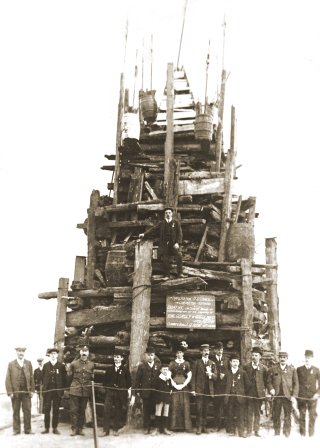 |
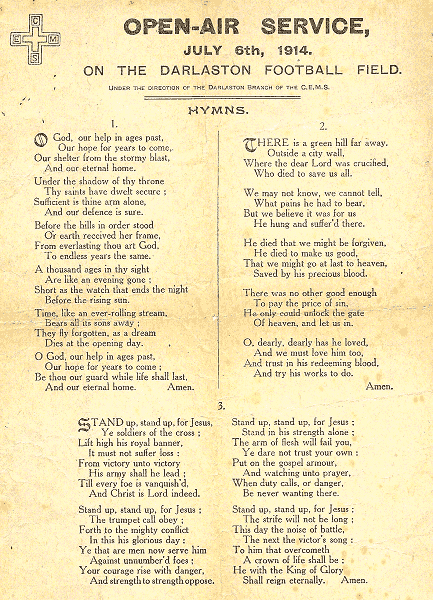 |
Just before the outbreak
of World War One, the Darlaston branch of the Church
of England Men's Society held an open-air service at
Darlaston football ground.
The society was founded in
1899 by Archbishop Frederick Temple, to bring men
together who worshipped in C. of E. churches, in
order to socialise in a Christian environment, and
to promote their interests.
I must thank Christine and
John Ashmore for the copy of the hymn sheet.
|
|
Darlaston's
Territorials In 1880 a company of
volunteers attached to the Wolverhampton
battalion was formed under the command of
Captain C. Walsh Graham and Lieutenant W. Guy.
Their headquarters were at the White Lion Inn in
King Street. This was followed by the Darlaston Territorial Force
which was part of
the
South Staffordshire Regiment. In 1909 it
consisted of one company of the 6th Battalion.
The Commanding Officer was Captain A. H. McBean
who lived at Tyninghame, Tettenhall. The other
officers were Lieutenant P. Douglas Barlow
and 2nd Lieutenant L. C. B. Joynson.
The headquarters were at St. Joseph's School, Church
Street. All information as to recruiting, etc.
could be obtained from Sergeant Frank Firman, Gale
House, Franchise Street, King's Hill.
In
1916 the Territorial Force formed 'F'
Company, part of the 6th Battalion. In the early
1920s it formed two Platoons of 'D' Company, 6th
Battalion South Staffordshire Regiment. There
were 140 members. The Commanding Officer was
Lieutenant J. C. Green in 1921, followed by
Captain P. J. Slater in 1922. In 1921 the
Command Sergeant Major was
J. Bryan, who was followed by H. G. Groves
in 1922. E. Turner was
Company Quartermaster Sergeant and the
Instructor in 1921 was Command Sergeant Major
G. R. Scandrett who was followed in 1922
by Sergeant S. Brindley. By this time meetings
were held in the Drill Hall, in Church Street.
World War One In the 1914 - 1918 world war many people joined the
local regiments and went to fight in France. Local
factories also played their part by producing munitions
for the war effort. Two hundred and sixty eight
Darlaston people were killed in the war. The war
memorial in Victoria Road, built as a tribute to
them, was completed in the mid 1920s. |
| |
|
|
|
|
 |
|
 |
|
 |
Visit Darlaston's
War Memorial |
|
Read about some
who lost their lives |
|
Read about some
who returned |
| |
|
|
|
|
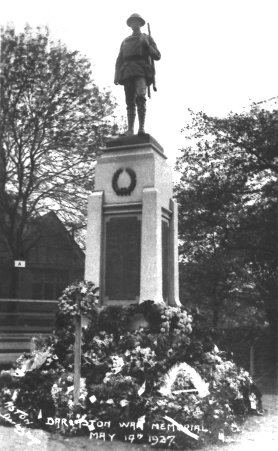 |
|
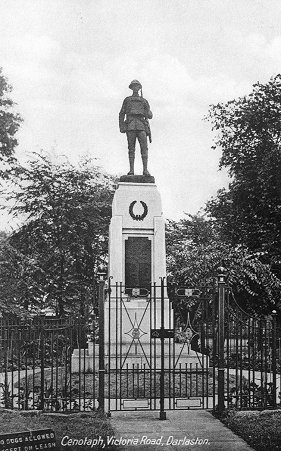 |
|
From the late Howard Madeley's
collection. |
|
| One of the main topics of conversation in
early January 1916 was the untimely death of the
local industrialist Francis Henry Lloyd who died
at James Bridge, and was sadly missed. On that fateful day, he worked as usual at James
Bridge Steel Works, then headed for James Bridge Railway
Station to catch his train home. He always took a short cut
across the London & North Western Railway lines, whilst on
his way to the station. He was spotted leaving the factory
and walking to the railway line by the L.N.W.R. signalman,
William Reynolds. As he approached the railway, he noticed a
locomotive moving towards him at walking pace, and
hesitated. The driver blew his whistle and Mr. Lloyd got
clear of the line. Within three or four yards of the
oncoming engine, he hesitated, then decided to cross the
track in front of the engine. The driver, Henry Carnell,
immediately applied the brake, but by that time Mr. Lloyd
had been knocked to the ground as the locomotive passed over
him. The estimated speed was four miles per hour.
Francis Henry Lloyd was badly injured,
and taken to the Queen Victoria Nursing Institute at
Wolverhampton. It was found that he had a fractured skull,
and so an operation was immediately performed. Although this
gave him some relief, and he regained consciousness, he died
during the evening.
At the inquest the verdict was
accidental death. His funeral was attended by a large number
of mourners, including over two hundred members of his
staff. He was buried beside his wife in the north east
corner of St. Chad’s Churchyard, Lichfield. |
| |
|
|
|
|
View a 1918
Darlaston
trades directory |
 |
|
View a 1921
general directory |
 |
| |
|
|
|
|
 |
 |
 |
Return to
Trams |
Return to
Contents |
Proceed to
Cinemas |
|